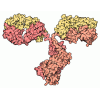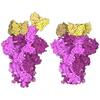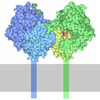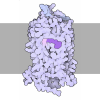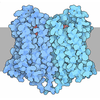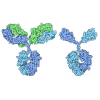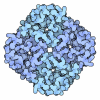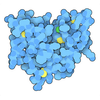[English] 日本語
 Yorodumi
Yorodumi- PDB-9as4: Global reconstruction of 5-HT2AR bound to LSD in complex with a m... -
+ Open data
Open data
- Basic information
Basic information
| Entry | Database: PDB / ID: 9as4 | ||||||||||||||||||||||||
|---|---|---|---|---|---|---|---|---|---|---|---|---|---|---|---|---|---|---|---|---|---|---|---|---|---|
| Title | Global reconstruction of 5-HT2AR bound to LSD in complex with a mini-Gq protein and scFv16 obtained by cryo-electron microscopy (cryoEM) | ||||||||||||||||||||||||
 Components Components |
| ||||||||||||||||||||||||
 Keywords Keywords | MEMBRANE PROTEIN / GPCR / G-protein Coupled Receptor / 5-HT2AR / serotonin / psychedelics | ||||||||||||||||||||||||
| Function / homology |  Function and homology information Function and homology informationprotein localization to cytoskeleton / positive regulation of heat generation / 1-(4-iodo-2,5-dimethoxyphenyl)propan-2-amine binding / Gq/11-coupled serotonin receptor activity / positive regulation of phosphatidylinositol biosynthetic process / G protein-coupled serotonin receptor signaling pathway / G protein-coupled serotonin receptor complex / neurofilament / cell body fiber / phospholipase C-activating serotonin receptor signaling pathway ...protein localization to cytoskeleton / positive regulation of heat generation / 1-(4-iodo-2,5-dimethoxyphenyl)propan-2-amine binding / Gq/11-coupled serotonin receptor activity / positive regulation of phosphatidylinositol biosynthetic process / G protein-coupled serotonin receptor signaling pathway / G protein-coupled serotonin receptor complex / neurofilament / cell body fiber / phospholipase C-activating serotonin receptor signaling pathway / artery smooth muscle contraction / positive regulation of cytokine production involved in immune response / Serotonin receptors / serotonin receptor activity / G protein-coupled serotonin receptor activity / sensitization / serotonin receptor signaling pathway / urinary bladder smooth muscle contraction / neurotransmitter receptor activity / serotonin binding / positive regulation of platelet aggregation / negative regulation of synaptic transmission, glutamatergic / positive regulation of DNA biosynthetic process / temperature homeostasis / positive regulation of vasoconstriction / detection of temperature stimulus involved in sensory perception of pain / regulation of dopamine secretion / negative regulation of potassium ion transport / protein tyrosine kinase activator activity / positive regulation of execution phase of apoptosis / G protein-coupled receptor signaling pathway, coupled to cyclic nucleotide second messenger / detection of mechanical stimulus involved in sensory perception of pain / positive regulation of fat cell differentiation / behavioral response to cocaine / release of sequestered calcium ion into cytosol / presynaptic modulation of chemical synaptic transmission / positive regulation of glycolytic process / dendritic shaft / glycolytic process / caveola / memory / Olfactory Signaling Pathway / Activation of the phototransduction cascade / intracellular calcium ion homeostasis / G beta:gamma signalling through PLC beta / Presynaptic function of Kainate receptors / Thromboxane signalling through TP receptor / G protein-coupled acetylcholine receptor signaling pathway / Activation of G protein gated Potassium channels / Inhibition of voltage gated Ca2+ channels via Gbeta/gamma subunits / G-protein activation / positive regulation of inflammatory response / G beta:gamma signalling through CDC42 / Prostacyclin signalling through prostacyclin receptor / Glucagon signaling in metabolic regulation / G beta:gamma signalling through BTK / Synthesis, secretion, and inactivation of Glucagon-like Peptide-1 (GLP-1) / ADP signalling through P2Y purinoceptor 12 / photoreceptor disc membrane / Sensory perception of sweet, bitter, and umami (glutamate) taste / Glucagon-type ligand receptors / Adrenaline,noradrenaline inhibits insulin secretion / Vasopressin regulates renal water homeostasis via Aquaporins / Glucagon-like Peptide-1 (GLP1) regulates insulin secretion / G alpha (z) signalling events / ADP signalling through P2Y purinoceptor 1 / cellular response to catecholamine stimulus / ADORA2B mediated anti-inflammatory cytokines production / G beta:gamma signalling through PI3Kgamma / Cooperation of PDCL (PhLP1) and TRiC/CCT in G-protein beta folding / adenylate cyclase-activating dopamine receptor signaling pathway / GPER1 signaling / positive regulation of neuron apoptotic process / Inactivation, recovery and regulation of the phototransduction cascade / G-protein beta-subunit binding / cellular response to prostaglandin E stimulus / heterotrimeric G-protein complex / G alpha (12/13) signalling events / sensory perception of taste / extracellular vesicle / signaling receptor complex adaptor activity / Thrombin signalling through proteinase activated receptors (PARs) / positive regulation of cytosolic calcium ion concentration / retina development in camera-type eye / presynaptic membrane / virus receptor activity / GTPase binding / Ca2+ pathway / cytoplasmic vesicle / fibroblast proliferation / High laminar flow shear stress activates signaling by PIEZO1 and PECAM1:CDH5:KDR in endothelial cells / G alpha (i) signalling events / G alpha (s) signalling events / phospholipase C-activating G protein-coupled receptor signaling pathway / G alpha (q) signalling events / chemical synaptic transmission / Ras protein signal transduction / postsynaptic membrane / Extra-nuclear estrogen signaling / positive regulation of ERK1 and ERK2 cascade Similarity search - Function | ||||||||||||||||||||||||
| Biological species |  Homo sapiens (human) Homo sapiens (human) | ||||||||||||||||||||||||
| Method | ELECTRON MICROSCOPY / single particle reconstruction / cryo EM / Resolution: 3.06 Å | ||||||||||||||||||||||||
 Authors Authors | Gumpper, R.H. / Fay, J.F. / Roth, B.L. | ||||||||||||||||||||||||
| Funding support |  United States, 1items United States, 1items
| ||||||||||||||||||||||||
 Citation Citation |  Journal: Nat Commun / Year: 2025 Journal: Nat Commun / Year: 2025Title: The structural diversity of psychedelic drug actions revealed. Authors: Ryan H Gumpper / Manish K Jain / Kuglae Kim / Renhong Sun / Ning Sun / Zhongli Xu / Jeffrey F DiBerto / Brian E Krumm / Nicholas J Kapolka / H Ümit Kaniskan / David E Nichols / Jian Jin / ...Authors: Ryan H Gumpper / Manish K Jain / Kuglae Kim / Renhong Sun / Ning Sun / Zhongli Xu / Jeffrey F DiBerto / Brian E Krumm / Nicholas J Kapolka / H Ümit Kaniskan / David E Nichols / Jian Jin / Jonathan F Fay / Bryan L Roth /   Abstract: There is currently a resurgence in exploring the utility of classical psychedelics to treat depression, addiction, anxiety disorders, cluster headaches, and many other neuropsychiatric disorders. A ...There is currently a resurgence in exploring the utility of classical psychedelics to treat depression, addiction, anxiety disorders, cluster headaches, and many other neuropsychiatric disorders. A biological target of these compounds, and a hypothesized target for their therapeutic actions, is the 5-HT serotonin receptor. Here, we present 7 cryo-EM structures covering all major compound classes of psychedelic and non-psychedelic agonists, including a β-arrestin-biased compound RS130-180. Identifying the molecular interactions between various psychedelics and the 5-HT receptor reveals both common and distinct motifs among the examined psychedelic chemotypes. These findings lead to a broader mechanistic understanding of 5-HT activation, which can catalyze the development of novel chemotypes with potential therapeutic utility and fewer side effects. | ||||||||||||||||||||||||
| History |
|
- Structure visualization
Structure visualization
| Structure viewer | Molecule:  Molmil Molmil Jmol/JSmol Jmol/JSmol |
|---|
- Downloads & links
Downloads & links
- Download
Download
| PDBx/mmCIF format |  9as4.cif.gz 9as4.cif.gz | 224.6 KB | Display |  PDBx/mmCIF format PDBx/mmCIF format |
|---|---|---|---|---|
| PDB format |  pdb9as4.ent.gz pdb9as4.ent.gz | 169.4 KB | Display |  PDB format PDB format |
| PDBx/mmJSON format |  9as4.json.gz 9as4.json.gz | Tree view |  PDBx/mmJSON format PDBx/mmJSON format | |
| Others |  Other downloads Other downloads |
-Validation report
| Summary document |  9as4_validation.pdf.gz 9as4_validation.pdf.gz | 1.3 MB | Display |  wwPDB validaton report wwPDB validaton report |
|---|---|---|---|---|
| Full document |  9as4_full_validation.pdf.gz 9as4_full_validation.pdf.gz | 1.3 MB | Display | |
| Data in XML |  9as4_validation.xml.gz 9as4_validation.xml.gz | 39.9 KB | Display | |
| Data in CIF |  9as4_validation.cif.gz 9as4_validation.cif.gz | 60.1 KB | Display | |
| Arichive directory |  https://data.pdbj.org/pub/pdb/validation_reports/as/9as4 https://data.pdbj.org/pub/pdb/validation_reports/as/9as4 ftp://data.pdbj.org/pub/pdb/validation_reports/as/9as4 ftp://data.pdbj.org/pub/pdb/validation_reports/as/9as4 | HTTPS FTP |
-Related structure data
| Related structure data |  43804MC 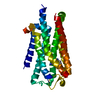 9arxC 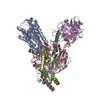 9aryC 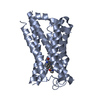 9arzC 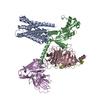 9as0C 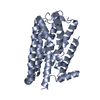 9as1C 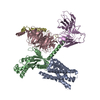 9as2C 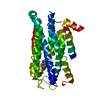 9as3C 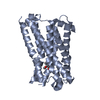 9as5C 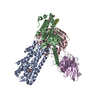 9as6C  9as7C 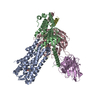 9as8C 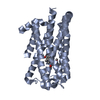 9as9C 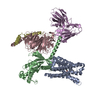 9asaC M: map data used to model this data C: citing same article ( |
|---|---|
| Similar structure data | Similarity search - Function & homology  F&H Search F&H Search |
- Links
Links
- Assembly
Assembly
| Deposited unit | 
|
|---|---|
| 1 |
|
- Components
Components
-Protein , 2 types, 2 molecules AB
| #1: Protein | Mass: 52648.945 Da / Num. of mol.: 1 Source method: isolated from a genetically manipulated source Source: (gene. exp.)  Homo sapiens (human) / Gene: HTR2A, HTR2 / Production host: Homo sapiens (human) / Gene: HTR2A, HTR2 / Production host:  |
|---|---|
| #2: Protein | Mass: 28084.832 Da / Num. of mol.: 1 Source method: isolated from a genetically manipulated source Source: (gene. exp.)  Homo sapiens (human) / Production host: Homo sapiens (human) / Production host:  |
-Guanine nucleotide-binding protein ... , 2 types, 2 molecules CD
| #3: Protein | Mass: 39418.086 Da / Num. of mol.: 1 Source method: isolated from a genetically manipulated source Source: (gene. exp.)  Homo sapiens (human) / Gene: GNB1 / Production host: Homo sapiens (human) / Gene: GNB1 / Production host:  |
|---|---|
| #4: Protein | Mass: 7861.143 Da / Num. of mol.: 1 Source method: isolated from a genetically manipulated source Source: (gene. exp.)  Homo sapiens (human) / Gene: GNG2 / Production host: Homo sapiens (human) / Gene: GNG2 / Production host:  |
-Antibody / Non-polymers , 2 types, 2 molecules E

| #5: Antibody | Mass: 28668.922 Da / Num. of mol.: 1 Source method: isolated from a genetically manipulated source Source: (gene. exp.)  Homo sapiens (human) / Production host: Homo sapiens (human) / Production host:  |
|---|---|
| #6: Chemical | ChemComp-7LD / ( |
-Details
| Has ligand of interest | Y |
|---|---|
| Has protein modification | Y |
-Experimental details
-Experiment
| Experiment | Method: ELECTRON MICROSCOPY |
|---|---|
| EM experiment | Aggregation state: PARTICLE / 3D reconstruction method: single particle reconstruction |
- Sample preparation
Sample preparation
| Component | Name: 5-HT2AR in complex with mini-Gq / Type: COMPLEX / Entity ID: #1-#5 / Source: RECOMBINANT |
|---|---|
| Source (natural) | Organism:  Homo sapiens (human) Homo sapiens (human) |
| Source (recombinant) | Organism:  |
| Buffer solution | pH: 7.4 |
| Specimen | Embedding applied: NO / Shadowing applied: NO / Staining applied: NO / Vitrification applied: YES |
| Vitrification | Cryogen name: ETHANE-PROPANE |
- Electron microscopy imaging
Electron microscopy imaging
| Experimental equipment | 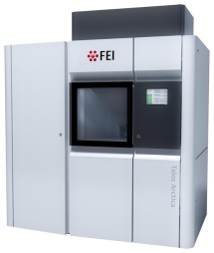 Model: Talos Arctica / Image courtesy: FEI Company |
|---|---|
| Microscopy | Model: FEI TALOS ARCTICA |
| Electron gun | Electron source:  FIELD EMISSION GUN / Accelerating voltage: 200 kV / Illumination mode: OTHER FIELD EMISSION GUN / Accelerating voltage: 200 kV / Illumination mode: OTHER |
| Electron lens | Mode: OTHER / Nominal defocus max: 2600 nm / Nominal defocus min: 160 nm |
| Image recording | Electron dose: 49.5 e/Å2 / Film or detector model: GATAN K3 (6k x 4k) |
- Processing
Processing
| EM software | Name: PHENIX / Category: model refinement | ||||||||||||||||||||||||
|---|---|---|---|---|---|---|---|---|---|---|---|---|---|---|---|---|---|---|---|---|---|---|---|---|---|
| CTF correction | Type: PHASE FLIPPING AND AMPLITUDE CORRECTION | ||||||||||||||||||||||||
| 3D reconstruction | Resolution: 3.06 Å / Resolution method: FSC 0.143 CUT-OFF / Num. of particles: 168657 / Symmetry type: POINT | ||||||||||||||||||||||||
| Refinement | Highest resolution: 3.06 Å Stereochemistry target values: REAL-SPACE (WEIGHTED MAP SUM AT ATOM CENTERS) | ||||||||||||||||||||||||
| Refine LS restraints |
|
 Movie
Movie Controller
Controller















 PDBj
PDBj
